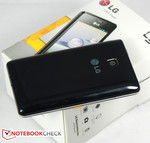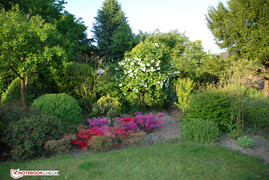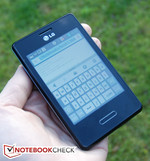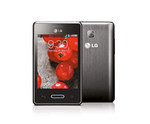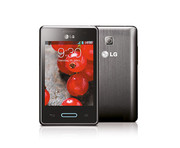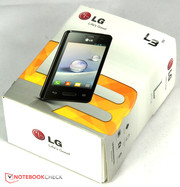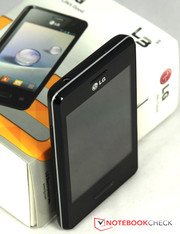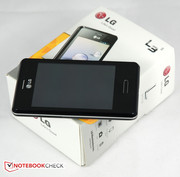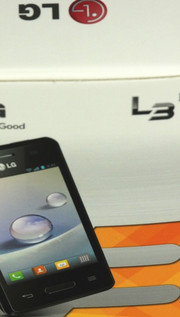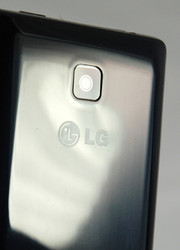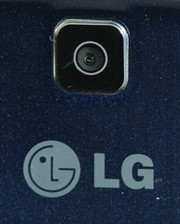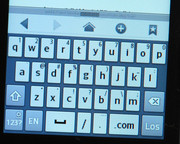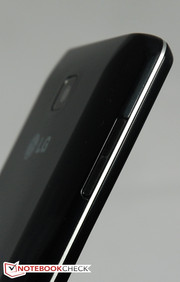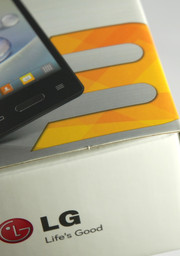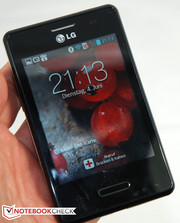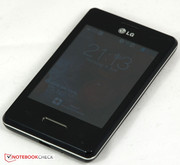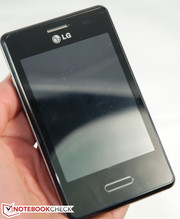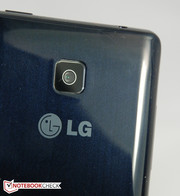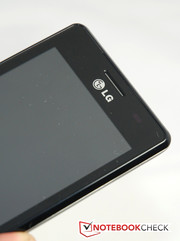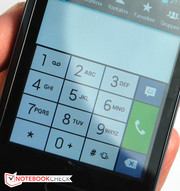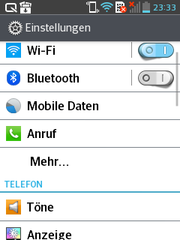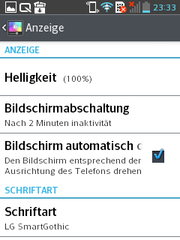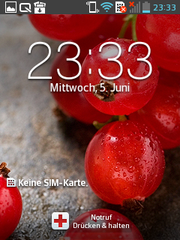Review LG Optimus E430 L3 II Smartphone

For the original German review, see here.
With a display measuring only 3.2-inches, the LG E430 Optimus L3 II is quite tiny. The size makes the battery life advertised by the Korean manufacturer seem even more amazing. Where does the dwarf keep all its battery reserves? According to the manufacturer, the battery is sufficient for up to 700 hours of standby time, which has the potential to sustain the battery for about a month without the user needing to connect the phone to its charger. The 600 minutes of talk time that LG offers also piques our curiosity. Is the dwarf smartphone really such a battery giant? We'll explore that question in the following review. Of course, we'll also take a look at the device's performance and connectivity - especially in comparison to its recently tested big brothers, the LG P710 Optimus L7 II and LG E460 Optimus L5 II. Our review candidate, equipped with a Qualcomm Snapdragon MSM7225A CPU with a clock rate of 1 GHz, is the cheapest device of the LG trio, though that doesn't necessarily mean anything. So let's go ahead and give the little guy a chance to impress us with his abilities.
Case
The word "simple" best describes our first impression of the 99 Euros (~$129) LG device's 11.9 x 102.6 x 61.1 mm (0.47 x 4.04 x 2.41 inch) case. Simple isn't to be confused with mundane or bad; there are certainly more expensive devices that are less visually appealing than LG's entry-level model. At 107 grams (3.77 oz), the very light device is about the size of a cigarette box, but much thinner. The case is constructed predominantly with dark plastic. The back shell of the case is composed of one piece of black plastic and can be very easily removed with two hands. The back shell weighs practically nothing and is razor-thin, and the feeling of lightweight construction thrusts itself front and center. But that isn't the primary feel of the device. Despite the case's thin construction, it's quite stable and withstands our attempts to twist it relatively well.
Under the back shell of the case you'll find the battery, which you can remove to access the SIM card slot. The slot accepts the standard card size. To the left, next to the battery bay, you'll find the microSD card slot, which can be used to expand the device's memory by up to 32 GB. That of course means you have to remove the back shell every time you want to access the slot.
All in all, the device makes a good impression, both in terms of look and feel. The dimensions of all the slits work perfectly, the design is simple, the silver accent around the border spruces up the device a little, the glass front is set in the case in a refined fashion - but we still couldn't shake the subliminal "lightweight construction" feeling. However, at a price of under 99 Euros (~$129), we can't really complain. Considering the case's manufacturing, we can confidently say that its price-to-quality ratio is consistent.
Connectivity
Equipped with a Qualcomm Snapdragon MSM7225A processor with a clock rate of 1 GHz and an Adreno 200 GPU, the LG E430 Optimus L3 II proves to have a solid hardware base for an entry-level smartphone. In terms of connections too, the device offers everything you could expect from a model in its class. Next to a microUSB port, through which the device is charged, you'll find a 3.5 mm audio port for either headsets or headphones. You'll also find a microSD card slot for memory cards up to 32 GB, with which the phone's 4 GB of internal memory (about 1.6 GB of that is available to the user) can be expanded.
Accessories
In the simple packaging you'll find the device, its battery and power supply, a data cable and a quick start guide.
Warranty
LG affords its device a warranty period of 24 months. However, the warranty for accessories like the battery or charger only lasts 6 months. In the case of a warranty claim, the customer can either turn to LG directly or the store where the device was purchased. The customer has to absorb the cost for shipment to LG themselves. Please be careful: LG only provides the 24 month warranty up to a maximum of 27 months past the manufacturing date. If you purchase a device that has been lying on a store shelf for a long time, you could end up with a shortened warranty period.
Communication & GPS
Via quad-band, it's possible to make calls to almost any cell phone network worldwide. Additionally, with the standards UMTS and HSDPA at its command, the device is able to reach quicker internet speeds. LTE is not available, but the WLAN transmits according to the current standards. Within the scope of our tests, we didn't find any fault with the phone's reception quality. The device's integrated GPS module executed its initial positioning within seconds, even in enclosed spaces.
Software
With Android 4.1 Jelly Bean, a very current version of Android is installed on the LG E430 Optimus L3 II. The operating system runs stably and fluidly. The OS has been slightly modified by LG, which is apparent, for example, on the visually altered home-screen, now with an emergency call function. Both the look and breakdown of the menus are also unusual. But after a short period of acclimatization, the modified system is easy to navigate.
Telephone Function
The telephone app is a minimally altered version of the Android standard and intuitive to operate.
Cameras & Multimedia
The built-in 3.0 MP camera isn't really a boon. It has a resolution of 2048x1536 pixels, 4x zoom and a voice-activated shutter release. The pictures it takes aren't of an especially high quality, the colors are pale and the images aren't very sharp. It is sufficient for snapshots, however. A front camera - for example for video calls - is not integrated.
Input Devices & Operation
Due to the small 3.2-inch display, the keys on the virtual keyboard are proportionately tiny. It's not just people with two left hands who'll have trouble with this one. However, the touchscreen's sensitivity is good, and at a price of below 100 Euros (~$131), there's nothing to complain about here.
Display
The resolution of the LG dwarf's 3.2-inch capacitive touchscreen is by no means a delight. With just 240x320 pixels, the image looks something like pixels that have been "crocheted" together. With a brightness value of a maximum of 412 cd/m2, however, the display's brightness is very good. Here the little LG lies considerably ahead of its 299 Euros (~$392) big brother, the LG P710 Optimus L7 II. The L7 II only reaches a maximum brightness value of 258 cd/m2.
| |||||||||||||||||||||||||
Brightness Distribution: 92 %
Center on Battery: 412 cd/m²
Contrast: 792:1 (Black: 0.52 cd/m²)
ΔE ColorChecker Calman: 5.4 | ∀{0.5-29.43 Ø4.77}
ΔE Greyscale Calman: 5.97 | ∀{0.09-98 Ø5}
Gamma: 2.51
CCT: 8061 K
Our analysis with the colorimeter and CalMAN software shows: Compared to the target color space, our test candidate's reproduction of the grayscale is not spectacular. The average DeltaE of 5.97 is relatively bad. In color reproduction, red and blue deviate most strongly from the target, but overall the results are good. The color saturation measurement is respectable. Here too, the red and blue deviate a little more from the target when the colors are strongly saturated. As regards color accuracy, the result is more or less mediocre. Blue tones deviate most strongly from the blues defined by the sRGB color space. Most of the grayscale doesn't match the ideal values either.
Due to its reflective surface, the display is limited in its usefulness outdoors. But it shares this problem with most of the competition. At more than 400 cd/m2, the display's brightness is respectable. For that reason the image content is still visible outside and in the sunshine, albeit not as visible as one might wish. In the shadows or indoors the user shouldn't have any difficulty viewing the screen. We would like to have seen a crisper contrast ratio, which certainly would have enhanced the display.
The little LG smartphone's viewing angle stability is also satisfactory. The image does fade a little at very flat angles, especially around the edges. But all in all, the display looks good from almost any direction. The colors never invert, nor is the entire display content ever "lost".
Performance
How does the 99 Euros (~$129) entry-level model's performance look? Can the LG E430 Optimus L3 II's Qualcomm Snapdragon MSM7225A CPU, with its clock rate of 1 GHz, and Adreno 200 GPU stand up to the competition? A look at the results from our performance benchmarks provides the answers. In the synthetic performance benchmark Androbench our test device comes in clearly ahead of its two LG competitors in the sequential write discipline, with 14.21 MB/s. It beats the Google Nexus 4 and the Chinese Amoi N821 here as well. Turning our attention to the Antutu benchmark V3, here too we see that the device doesn't do half bad in comparison to the rest of the competition. Here the little LG achieves a total score of 5685 points, placing itself safely in between the other devices. Only the Google Nexus 4 shoots far ahead of everyone else, with 17555 points.
| AndroBench 3-5 | |
| Random Write 4KB (sort by value) | |
| LG Optimus E430 L3 II | |
| LG P710 Optimus L7 II | |
| LG E460 Optimus L5 II | |
| Google Nexus 4 | |
| Amoi N821 | |
| Random Read 4KB (sort by value) | |
| LG Optimus E430 L3 II | |
| LG P710 Optimus L7 II | |
| LG E460 Optimus L5 II | |
| Google Nexus 4 | |
| Amoi N821 | |
| Sequential Write 256KB (sort by value) | |
| LG Optimus E430 L3 II | |
| LG P710 Optimus L7 II | |
| LG E460 Optimus L5 II | |
| Google Nexus 4 | |
| Amoi N821 | |
| Sequential Read 256KB (sort by value) | |
| LG Optimus E430 L3 II | |
| LG P710 Optimus L7 II | |
| LG E460 Optimus L5 II | |
| Google Nexus 4 | |
| Amoi N821 | |
However, the results from the graphics benchmarks are disillusioning. Here the integrated Adreno 200 GPU is pretty much decimated. In both disciplines of GLBenchmark 2.5 it finds itself on the bottom rung, and things don't look any different in NenaMark2.
| NenaMark2 - --- (sort by value) | |
| LG Optimus E430 L3 II | |
| LG P710 Optimus L7 II | |
| LG E460 Optimus L5 II | |
| Google Nexus 4 | |
| Amoi N821 | |
| GLBenchmark 2.5 | |
| 1920x1080 Egypt HD Offscreen Fixed Time (sort by value) | |
| LG Optimus E430 L3 II | |
| LG P710 Optimus L7 II | |
| LG E460 Optimus L5 II | |
| Google Nexus 4 | |
| Egypt HD Fixed Time (sort by value) | |
| LG Optimus E430 L3 II | |
| LG P710 Optimus L7 II | |
| LG E460 Optimus L5 II | |
| Google Nexus 4 | |
In the browser benchmark Google V8, our test device does poorly. With no more than 651 points, the LG 430 Optimus L3 II lies far behind the first-place finisher Google Nexus 4, with 1381 points. The JavaScript benchmark SunSpider 0.9.1 paints a similar picture. Here the LG smartphone comes to a slow 2716 ms, which is a considerably worse result than those achieved by its two LG competitors, the LG P710 Optimus L7 II and LG E460 Optimus L5 II.
| Google V8 Ver. 7 - Google V8 Ver. 7 Score (sort by value) | |
| LG Optimus E430 L3 II | |
| LG P710 Optimus L7 II | |
| LG E460 Optimus L5 II | |
| Google Nexus 4 | |
| Amoi N821 | |
| Sunspider - 0.9.1 Total Score (sort by value) | |
| LG Optimus E430 L3 II | |
| LG P710 Optimus L7 II | |
| LG E460 Optimus L5 II | |
| Google Nexus 4 | |
| Amoi N821 | |
* ... smaller is better
Games
Even if you don't consider the Adreno 200 GPU's limited performance capabilities, the tiny 3.2-inch display doesn't exactly provide the prerequisites for an enjoyable gaming experience. In "postage stamp format" the display is too small for anyone to want to play games that demand high graphics performance. Simple games like Angry Birds do work, but because operating the little touchscreen is rather tricky, it's not a whole lot of fun.
Voice Quality
The smartphone's voice quality is good. We don't notice any bothersome background noise, the conversation partner's speech is easy to understand, and the voice we hear sounds natural. Only on speaker phone does the voice sound a little tinny.
Emissions
Unlike its two LG siblings, the LG P710 Optimus L7 II and LG E460 Optimus L5 II, at a maximum of 38.5 °C (101.3 °F) our dwarf test device warms up quite a bit under load. The two LG competitors remain under 37 °C (98.6 °F) here. However, in idle mode, at a maximum of 30.3 °C (86.5 °F), it does better than its two big brothers, which both reach temperatures of over 33 °C (91.4 °F). Overall, the little smartphone's temperatures remain in a good, unproblematic range.
(+) The maximum temperature on the upper side is 38.5 °C / 101 F, compared to the average of 35.2 °C / 95 F, ranging from 21.9 to 247 °C for the class Smartphone.
(+) The bottom heats up to a maximum of 34.1 °C / 93 F, compared to the average of 34 °C / 93 F
(+) In idle usage, the average temperature for the upper side is 29.2 °C / 85 F, compared to the device average of 32.9 °C / 91 F.
Speaker
The little mono speaker on the front edge of the device can be turned up quite loud, and though the sound is treble-prone, overall it's satisfactory. Using the 3.5 mm jack you can plug in headphones. Neither in-ear headphones nor a headset are included in the packaging.
Energy Management
In this section we're choosing not to publish the measurements we took, as we doubt their accuracy very much. Despite the use of two different multimeters, our measurements tended towards 0 under all levels of load. At any rate, our findings in the following section on battery life are much more interesting and significant.
Battery Life
The dwarf is a true marathon runner when it comes to its 5.7 Wh lithium-ion battery's stamina. In the non-demanding reading test, at minimum brightness and with activated WLAN, the dwarf smartphone holds out a whole 36 hours and 14 minutes. The Apple iPhone 5 "only" reaches 22 hours here, and the Google Nexus 4, for example, only runs 11 hours and 55 minutes. In the more practically relevant WLAN surf test, with a display brightness of 150 cd/m2, the little LG device's battery keeps chugging along for 16 hours and 12 minutes. A clean performance. The LG Optimus L7 II's stamina is much weaker, as it only holds about 7 hours of battery life for this kind of use. Under full load during the stability test (CPU + GPU), our test device cuts out only after 5 hours and 26 minutes of racing along. Here too the dwarf mercilessly wipes out its competitors and proves its gift for "endurance running", as the competition runs out of steam after 2 to 4 hours.
Verdict
As our tests make clear, the cheap 99 Euros (~$129) Optimus 430 L3 II from the Korean manufacturer LG excels more than anything at "long-distance running". With a battery runtime of over 36 hours in the reading test, and still more than 16 hours in the WLAN surf test, the "battery giant" even beats potent devices like the Apple iPhone 5 - at least when it comes to battery life. With 1540 mAh, the dwarf's battery isn't especially large, but it manages to keep the cigarette-box sized smartphone running for hours and days - even weeks. This advantage should be appealing to travelers and outdoor fans especially, particularly as its low cost of under 100 Euros (~$131) makes it affordable as a second cell phone for vacation or outdoor activities, where a scratch here and there isn't a big deal. You don't generally want to expose an expensive cell phone to the elements, which you might otherwise have to do on hiking tours and the like. Here our review device recommends itself with its incredibly long standby times of up to a month between charges. All these characteristics make the phone ideal for long nature trips away from power sources.
When it comes to performance, the LG smartphone offers solid performance for a device in its price class. The performance benchmarks show that the Qualcomm Snapdragon CPU MSM7225A installed in the device isn't a high achiever, but nor does it come out with abominable marks. In the graphics tests things look a little different. Here the integrated Adreno 200 GPU lags considerably far behind the competition. But honestly: Who cares about graphics performance if you only have a 3.2-inch display at your disposal?
The inexpensive device is also recommendable for kids who would like a smartphone. The price and stable manufacturing make the phone interesting for parents looking to fulfill an adolescent's pleas for a smartphone of their own. But will kids actually find the simple, low-budget device cool? Seeing as at that age you rarely have the guts to rock the sophisticated understatement "meh", probably not.




